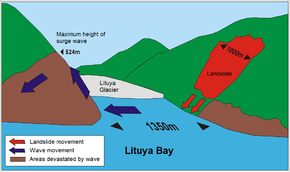
Back ميجاتسونامي Arabic Megatsunami Catalan Megatsunami Czech Megatsunami German Megatsunami Spanish Megatsunami Basque کلانسونامی Persian Megatsunami Finnish Mégatsunami French Megacunami Croatian

A megatsunami is a very large wave created by a large, sudden displacement of material into a body of water.
Megatsunamis have different features from ordinary tsunamis. Ordinary tsunamis are caused by underwater tectonic activity (movement of the earth's plates) and therefore occur along plate boundaries and as a result of earthquakes and the subsequent rise or fall in the sea floor that displaces a volume of water. Ordinary tsunamis exhibit shallow waves in the deep waters of the open ocean that increase dramatically in height upon approaching land to a maximum run-up height of around 30 metres (100 ft) in the cases of the most powerful earthquakes.[1] By contrast, megatsunamis occur when a large amount of material suddenly falls into water or anywhere near water (such as via a landslide, meteor impact, or volcanic eruption). They can have extremely large initial wave heights in the hundreds of metres, far beyond the height of any ordinary tsunami. These giant wave heights occur because the water is "splashed" upwards and outwards by the displacement.
Examples of modern megatsunamis include the one associated with the 1883 eruption of Krakatoa (volcanic eruption), the 1958 Lituya Bay megatsunami (a landslide which caused an initial wave of 524 metres (1,719 ft)), and the Vajont Dam landslide (caused by human activity destabilizing sides of valley). Prehistoric examples include the Storegga Slide (landslide), and the Chicxulub, Chesapeake Bay, and Eltanin meteor impacts.
- ^ "Tsunami Characteristics". Pacific Tsunami Museum. Retrieved 26 July 2021.